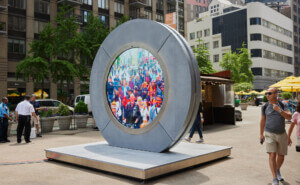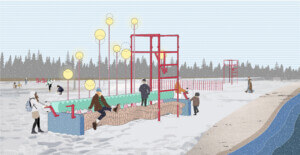The 2021 edition of the Chicago Architecture Biennial opened on Friday, September 17. Titled The Available City, it is a departure from previous iterations of North America’s largest architecture festival. It proposes to introduce visitors to contemporary architectural thinking not via exhibitions at the Chicago Cultural Center and installations within the well-touristed domain of the Loop, but almost exclusively through interventions on sites sprinkled throughout the city’s south and west sides.
These sites are predominately city-owned vacant lots in historically underserved Black and Brown neighborhoods. At most of the locations, CAB artistic director David Brown teamed architects from across the United States and around the world with local community groups to engage in collaborative design projects. In aggregate, the Biennial offers examples of how transparent, inclusive, community-led design processes can be a better alternative to the often opaque and insensitive machinations of urban development.
Be sure to look for an in-depth review of The Available City in the upcoming October/November issue of AN. In the meantime, the following are a few highlights of completed must-see installations (that’s right, some of the projects commissioned for CAB have not quite wrapped up construction, including Atelier Bow Wow’s pavilion at Englewood Village Plaza). And take note, all sites are best visited during active programming, so check in on the CAB website to make sure your visit is timed appropriately.
Cover the Grid and Block Party at Bell Park
1921 S. Drake Avenue
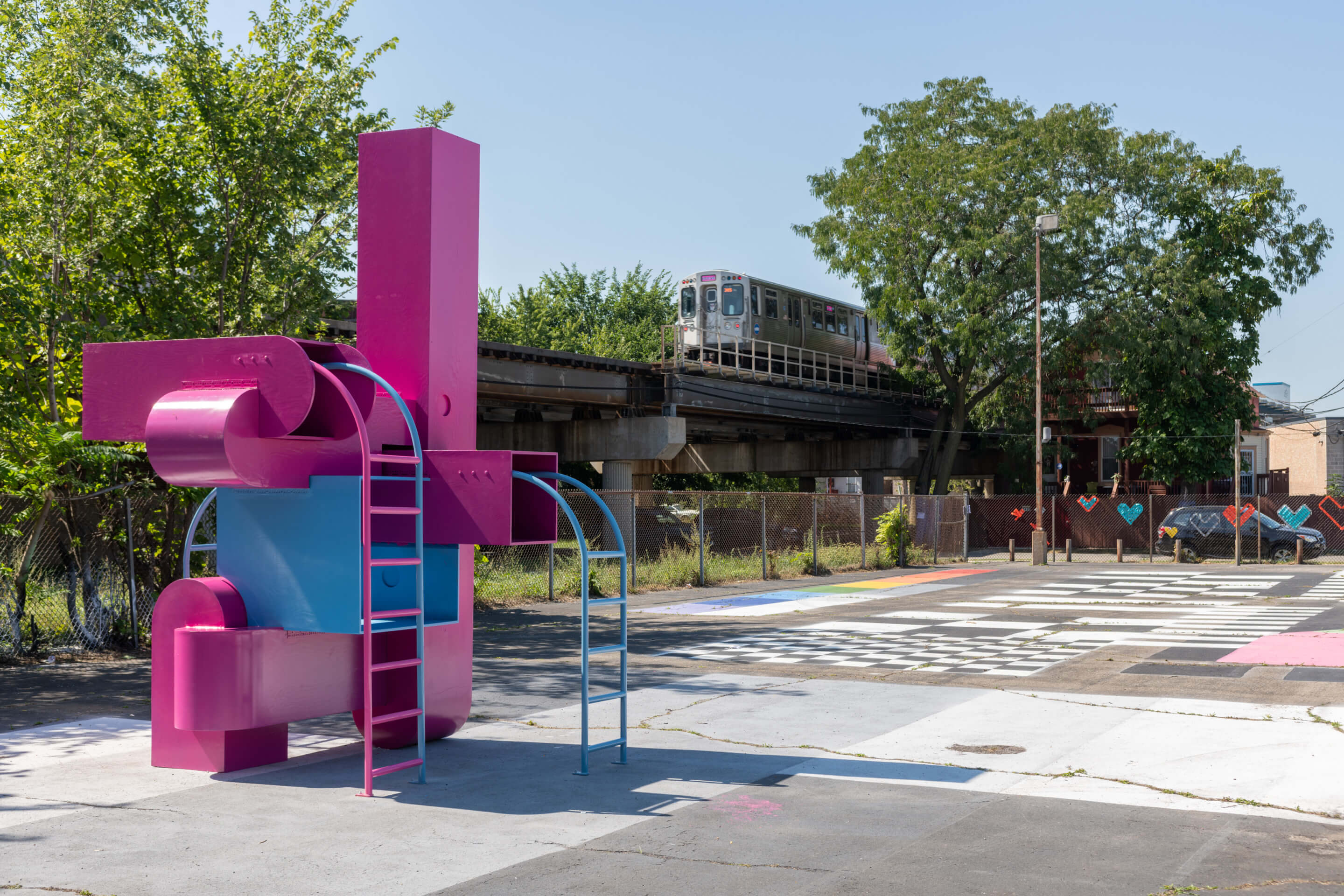
Two excellent projects can be seen at Bell Park in the westside neighborhood of North Lawndale. The park is an asphalt-covered lot in the shadow of the Pink Line L train that was home to two basketball hoops and not much else. Columbus, Ohio-based Outpost Office teamed with local organizations The Westside Association for Community Action, Open Architecture Chicago, and Freedom House Studios to create Cover the Grid. The project is a large-scale ground painting done with the assistance of GPS-guided robots ordinarily used to paint temporary sports fields. Here, they painted a basketball court in vibrant colors, as well as several other play spaces. Also at Bell Park is Block Party, by Studio Barnes (Miami), Shawhin Roudbari (Boulder, CO), and MAS Context (Chicago) in collaboration with the aforementioned community organizations. It’s a play structure that is inspired by the bouncy castles that are a ubiquitous feature of Chicago block parties. During opening weekend both installations were being heavily used with a pickup basketball game on the court and several children (and design journalists) climbing all over Block Party.
The Garden Table at El Paseo Community Garden
944 W. 21st Street
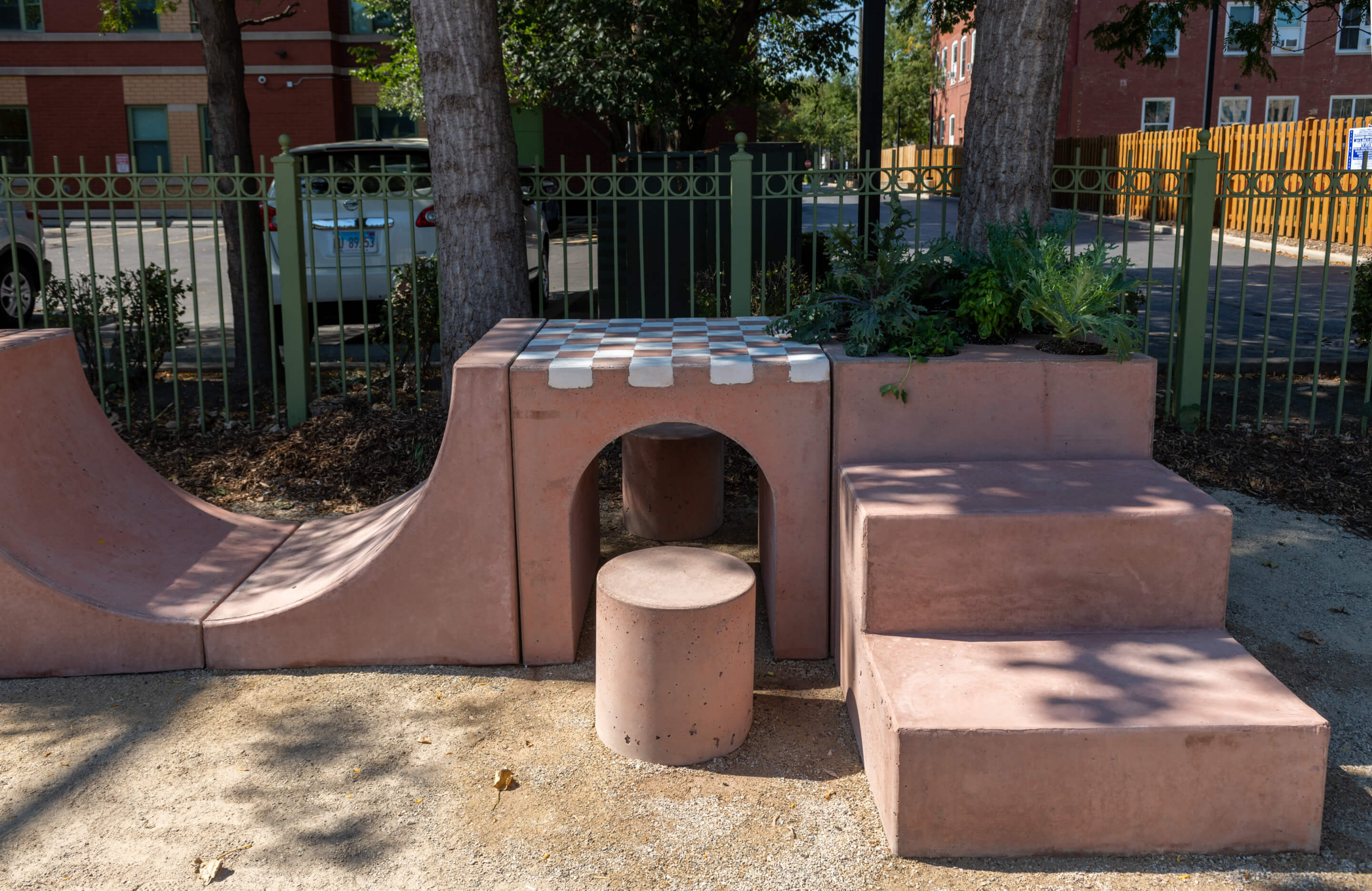
Dutch practice Studio Ossidiana teamed with the El Paseo Community Garden in Pilsen to create The Garden Table, a permanent installation that can be used and appreciated in many ways. For starters, the project capped a brownfield site within the community garden that had yet to be remediated. Atop the cap is The Garden Table, a robust assembly of modular cast concrete blocks that provide surfaces for eating, gameplay (chess, checkers, backgammon, and more), plantings, wildlife habitat, sitting, lying, climbing, or just looking at. The blocks’ simple shapes—circles, squares, arches, steps, triangles—are rendered in a dusty pink with rounded edges, making for an approachable and reassuring presence in what is already a well-established community space alive with vegetables, flowers, and beehives.
Grids + Griots at the YMEN North Lawndale Bike Box
1241 S. Pulaski Road
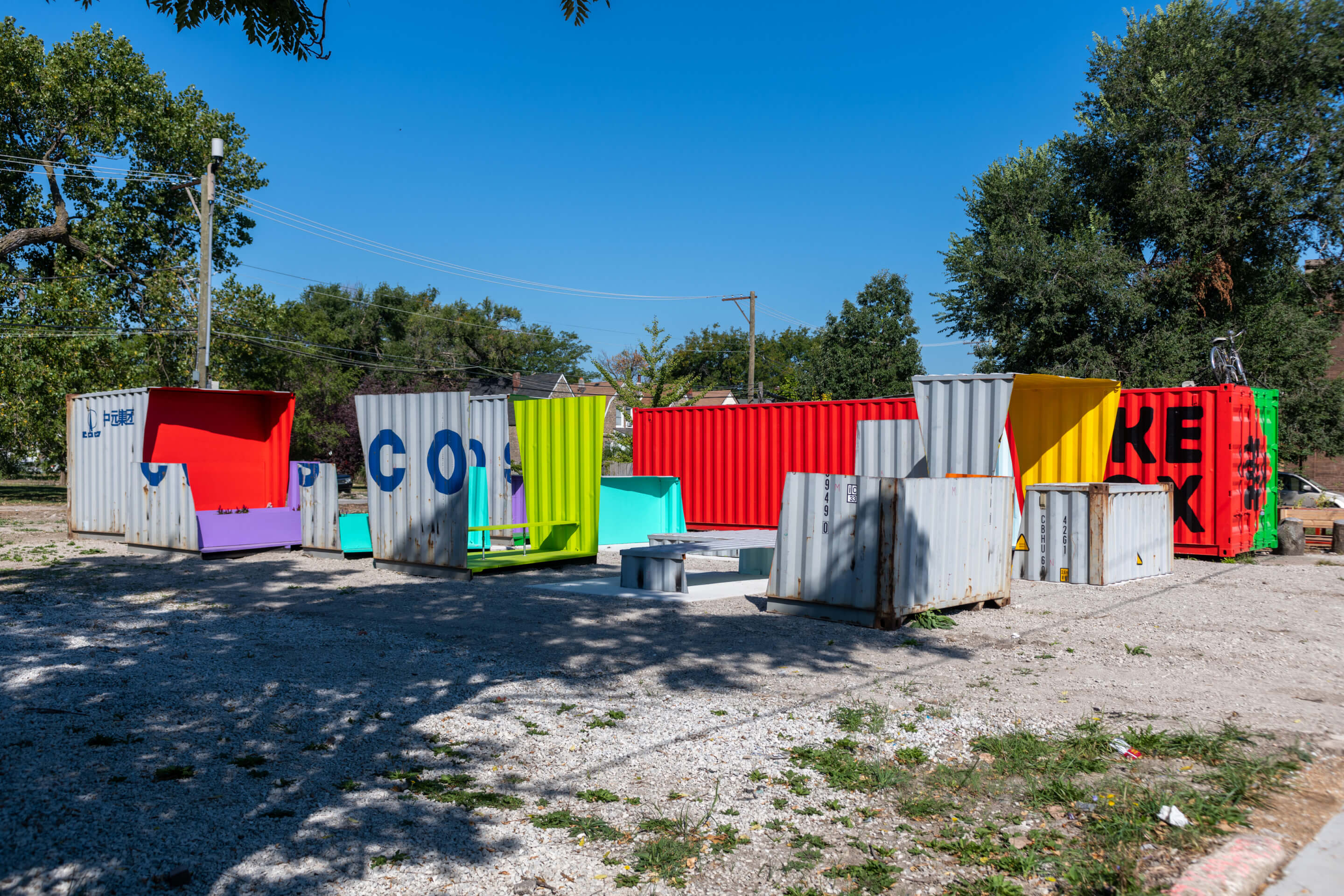
Charlotte, North Carolina-based sekou cooke STUDIO’s Grids + Griots is the result of a collaboration with YMEN, a youth leadership organization in North Lawndale. YMEN (the Young Men’s Employment Network) operates Bike Box, a bike shop, out of a shipping container adjacent to the Biennial site, where they have also built out a rain garden and raised planters. Cooke’s intervention plays off these elements like a DJ, remixing them for a variety of different uses. A 40-foot shipping container was chopped up into sections, painted vibrant colors, and distributed across the site. Cooke loves working with metaphors, and here, in addition to harnessing ideas from rap music, he references the griot, a traveling storyteller figure in many West African cultures. In addition to interpreting the chopped and remixed container sections as frozen hip hop, one may also view them as an expression of freedom as embodied by the griot, an irrepressible, footloose bard who determines their own path. (Also, while visiting Grids + Griots you can pop next door to see two other installations on Pulaski Road: Soil Lab, a still-in-progress rammed earth community center by a group of Irish and Danish architects working with the Danish Arts Foundation; and Living Room, a totemic circle of wooden knots and stone at the CCA Academy’s permaculture garden by local architects The Bittertang Farm.)
Woodlawn Canopies at Project H.O.O.D.
6615 S. King Drive
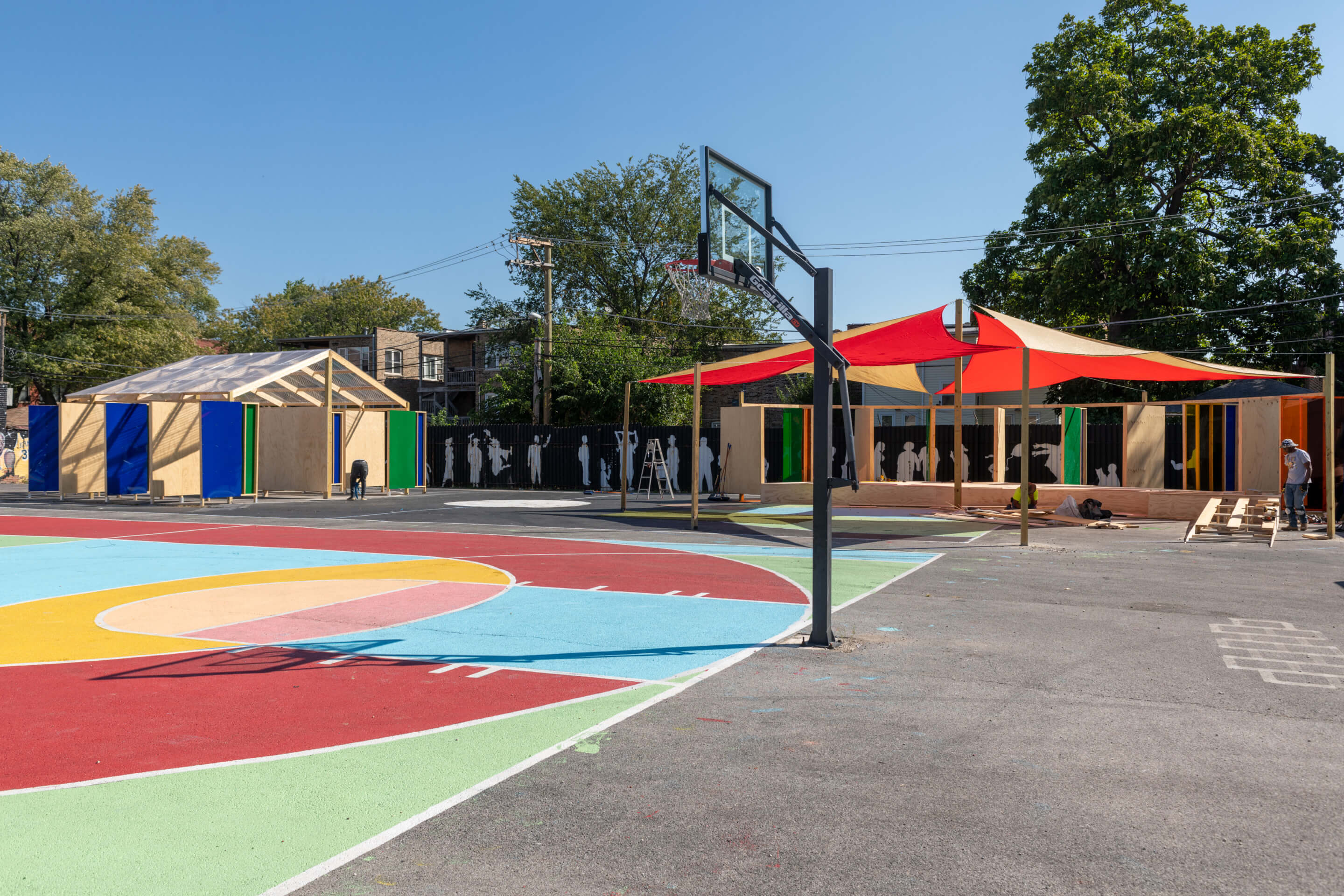
Local practices Norman Teague Design Studio and BNMO Design teamed with job training organization Project H.O.O.D. (Helping Others Obtain Destiny) to create Woodlawn Canopies: Stories and Futures. The project is located in the Woodlawn neighborhood on the South Side, on a site that was once home to a run-down motel that was a locus of criminal activity. The motel was demolished after local pastor Corey Brooks of the New Beginnings Church camped on its rooftop through the winter in protest of its continued presence, and then lobbied the city for control of the lot. In the future, a community center will be built on the site, but for now, it has been activated as a vibrant exhibition and gathering space with a stage where the history of Project H.O.O.D. will be presented and conversations about the future of the neighborhood will be conducted.








